On Friday, half price public transport fares came into effect as part of the government’s ‘cost of living relief package’, which has already seen petrol tax reduced by 25c per litre. The reduced price includes daily and monthly passes as well as existing concession fares. ATs implementation of package also includes ferry trips to/from Devonport as AT say the service’s inclusion in the Integrated Fares scheme would have made it too costly and ‘technically challenging’ to exclude – even though the government aren’t covering the cost of them due to Devonport ferries being commercial services not under ATs control. Waiheke services aren’t included in the package.
The minister refused to cover the costs for those services with Stuff reporting a letter from Transport Minister Michael Wood to both AT and Fullers saying
“I am immensely frustrated on behalf of the people of the affected communities that this (exemption) issue has not been resolved,” replied Wood to Horne, in letters obtained by Stuff from Wood’s office.
“AT and Fullers cannot have it both ways,” wrote the Minister.
“I am profoundly hacked off that this issue has not been fixed and I think that the parties concerned need to absorb a lesson here and sort it out – and cannot in my view now reasonably expect a government public transport subsidy for them.”
If the minister wants to get this sorted out once and for all he should use his powers under section 150(1)(b) of the Land Transport Management Act to revoke Fullers’ exempt service status for Devonport and Waiheke ferries, which are clearly ‘integral’ to the public transport network.
Putting aside these minor issues, the general lowering of the cost of PT is great and will certainly help to make it more attractive to use. I’m looking forward to seeing just what impact it has on PT usage. AT estimate it could increase usage by 10-15% but then that’s coming off a much lower base with PT usage at about 35-45% of what it was pre-COVID.

For their part AT are advertising this as a great opportunity to explore Auckland. Perhaps they should lean into that narrative even more and suggest some great PT trips people could take, especially ones that might help support business areas around the region.
As I noted at the time, one thing that stood out to me about the announcement of this package was indications from Deputy PM and Finance Minister Grant Robertson that this fare drop, or something like it could be extended in this year’s budget as part of the government’s response to their Emissions Reduction Plan.
While I’m certainly supportive of cheaper public transport, for many, price is often not the biggest barrier to its use. Instead, the quality of the service such as the route, the frequency and the reliability of the service is what is key. Put another way, a crap service that’s cheap (or even free) will still be a crap service.
That got me thinking about what some of other things are the government could do in the short to medium term to increase the usage of public transport.
Funding to further improve Services
The council have just finished the consultation period for their Annual budget, the centrepiece of which is a Climate Action Targeted Rate (CATR). The CATR more than $600 million invested to improve services above the level they currently are and will combine with other planned improvements to further enhance PT in Auckland.
The government could take this a step further with additional funding to speed up the implementation of the changes and/or provide for further enhancements to services. For example it would be great if we could get all frequent bus routes up to a minimum of every 10 minutes during the day instead of just every 15.
Better Bus Infrastructure
The media debate and stoking of outrage about on-street parking has been in overdrive over the last week or so following Auckland Transport seeking approval to consult on their updated Parking Strategy. Most of the focus has been on the impact removing parking from arterials might have on local shops, often ignoring the potential benefits. As Deputy Mayor Bill Cashmore said during the Council’s debate on it “One car is one shopper, a bus full of shoppers is a business.”
With Auckland Transport saying will consult on each time they look to remove parking from an arterial road it’s going to be a long time before we see significant change. AT themselves acknowledge this by noting that at present, only around 20% of arterial roads are proposed to see changes over the next 10 years.
The government have already shown a willingness to bust through council bureaucracy in other areas, such as their changes to housing rules. Perhaps they could do something similar for on-street parking by making it easier or even requiring its removal from some roads.
More bus lanes will help in speeding up buses but in addition we should also be speeding up buses by rationalising bus stops. In some parts of Auckland there are bus stops less than 150m apart. This can be useful for some, but it can result in much slower journeys. Along with making it easier to remove parking, the government could require that bus stops be rationalised.
In addition, the government could provide funding to improve bus stops in other ways. A big area that needs focus on it is how people access bus stops. This would include things such as adding pedestrian crossings at bus stop locations.
Better Trains
The City Rail Link will make a massive difference once it opens but there are many other things that could be done in the short term to improve trains and that are needed. I’ve covered this in more detail in the past but like with buses we need to see improvements to the speed of our trains, particularly dwell times, and improve the access to them. Improving access could include pedestrian crossings as well new connections to stations to open up catchments.

A package of projects to improve public transport by removing the pain points, combined with cheaper fares, would have long lasting impact and benefit new and existing users alike.
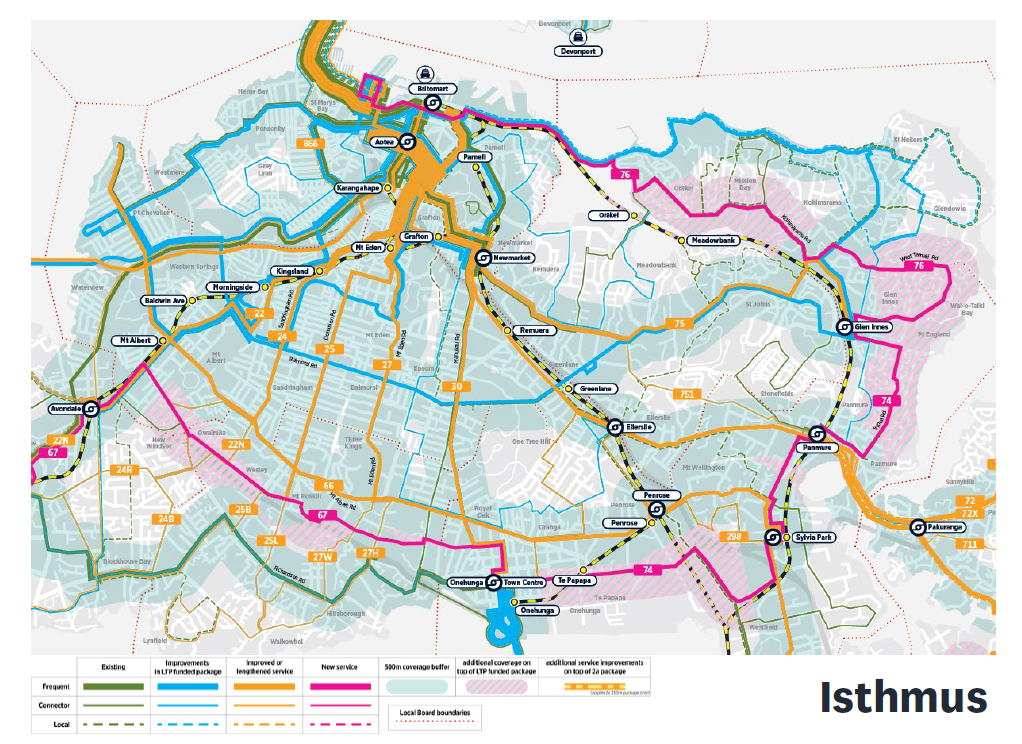
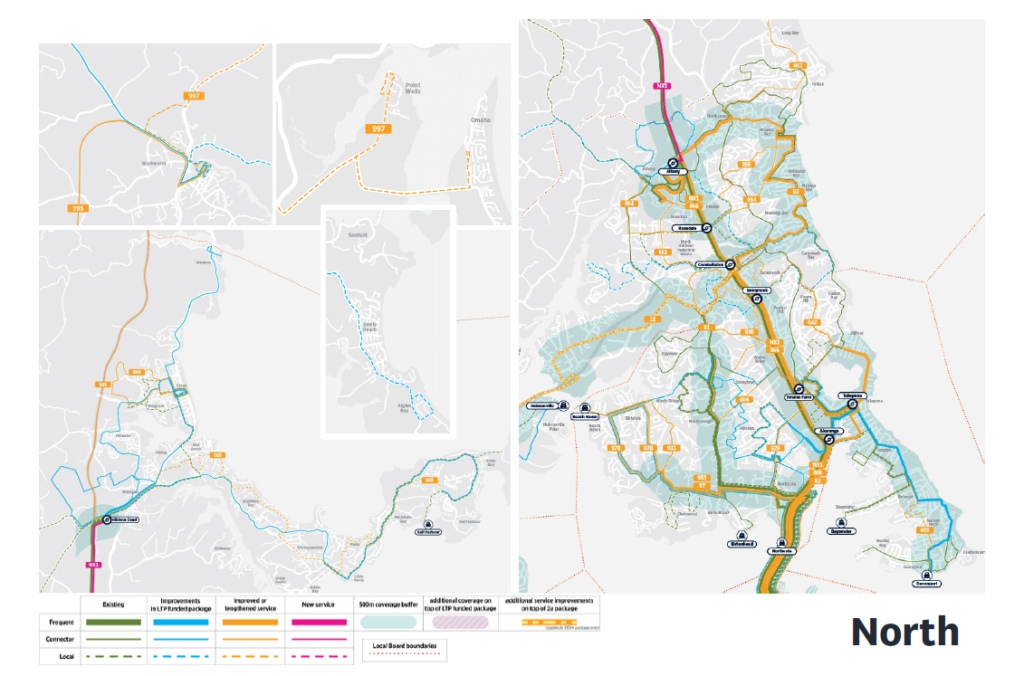
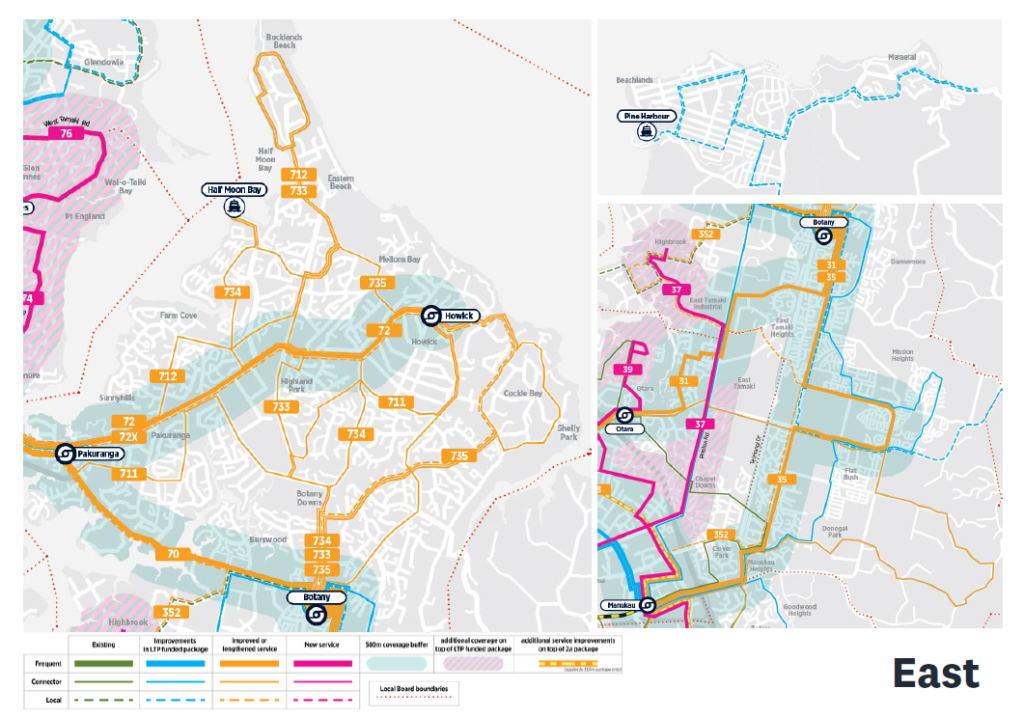
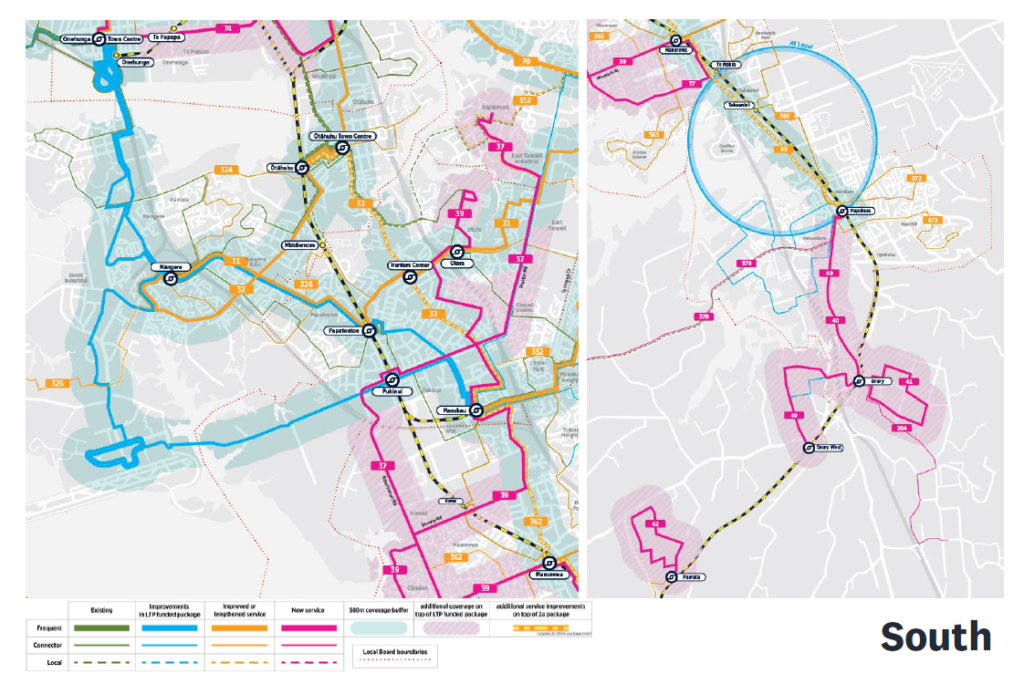
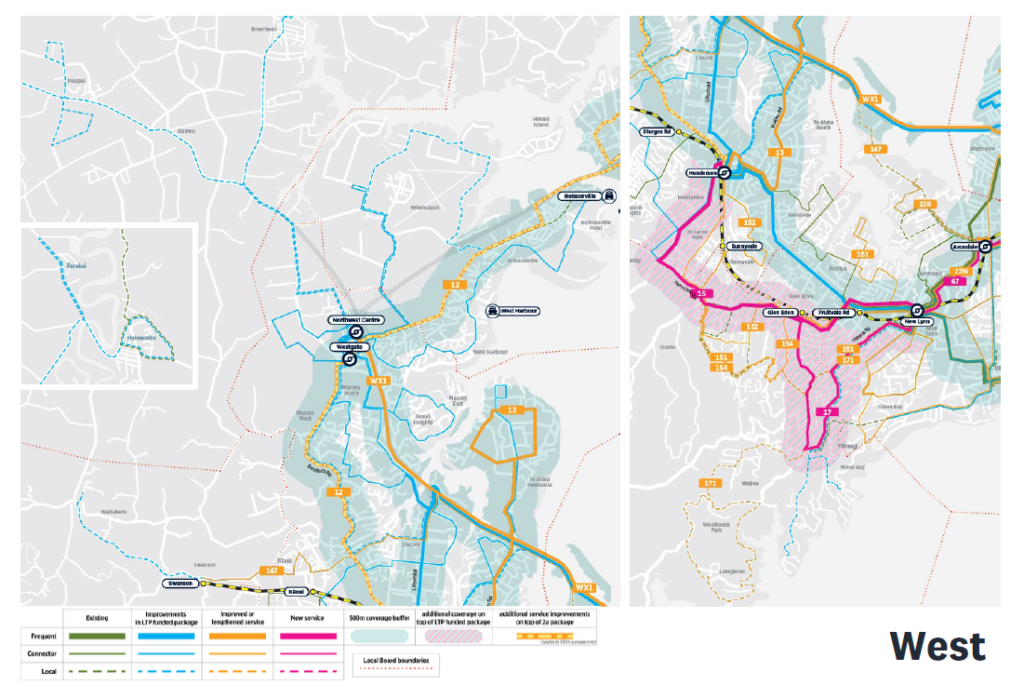

 Processing...
Processing...
Urgent, urgent: if you want to seriously improve patronage to meet the government’s climate targets, you have to build a decent RTN. What about a few million put into creating a bus-based “proto-RTN”, using these streets that are to be cleared for bus lanes, that could be in place within 12 months while we wait years (decades)? for light rail? It beggars belief that we are waiting so long for gold plated while tin-platwd would do a great job in the interim.
Yep. Give busses road space (a lane) and light priority, they will be faster than using a car along corridors. When people benefit by using PT that’s when you get really good patronage. They could implement this a lot lot faster if they wanted.
In AT you end up going in circles with this though, it’s never as easy as just add a bus lane. Cycle lanes have been shown on most frequent bus routes in their Future Connect Strategy. This means that taking a lane for cycling and taking a lane for buses is required.
Not saying it shouldn’t be done, it just means it’s a bit harder. See New North Road consultation now for what AT are trying to do.
It should be easy, take a lane from cars for busses and the cycle lane is taken from the pointless median that every road in Auckland seems to need to have, according to AT
It is tho. AT choose to not implement their exiting policy, because car parks.
I wonder if Michael Wood is even aware that he has the power to revoke exempt services under current legislation? This has been talked about for years, but isn’t a difficult process. Seems like another example of Ministers being let down by officials.
“One car is one shopper, a bus full of shoppers is a business.”
Good on Bill Cashmore – he gets it. It’s great to see a C&R councillor who can see beyond the usual National Party myopia.
it’s amazing how businesses don’t see such an obvious benefit. seems like they live in some kind of a bubble
Many small convenience shops, like wine shops and florists, still think that they need a carpark directly outside their shop, so Tabitha from Remmers can pop in for a bottle of bubbly on her way home.
as someone who lives on Waiheke, and who doesn’t have access to private helicopter access to and from the island, I’d like to say that the issue of the Waiheke service being excluded from the Public Transport Operating Model is more than “a minor issue”. Thanks
I wonder if Wood wants to rethink his position.
Labour promised that the PTOM would be rewritten and would likely remove this problem. One more thing they haven’t done!
The world has been stood on its head,by Covid,particularly people movement.It is very apparent, observing Auckland traffic,that moving around by private car is as easy as it has ever been, there is no advantage to taking public transport, apart from a financial one,that people never understand anyway.
Any changes to improve PT,at the moment,will be a hard sell,as all traffic is flowing ,it is only when gridlock happens,that PT is looked on as an option.
So I guess it is Catch 22,”why do we need PT improvement now” verses “why didn’t you fix this before “. We need some brave people to implement “travel change” and be prepared to cop some flak,so that when the time comes,and ” normal transmission ” is resumed,PT is able to deliver.
Work is proceeding on the third main project also the electrification from Papakura to Pukekohe. One downside is speed restrictions past active work sites so I don’t expect timetables can be speed up till this is finished. I had to make a run to Pukekohe recently in the afternoon peak I guess forty people got of the train at Pukekohe. I waited at the bus stop to see how many passengers got onto the three buses that left soon after. Two were empty and only one passenger on the other. I just wanted to go up the main street so I walked but I did notice the buses don’t go up the main street they go up the bypass which is about a 50 metre walk to the south. I wonder if this is a bit of a design flaw. Plenty of cars on the main street I didn’t
think to look to see if parking was being charged for but I expect not.
Welcome to Pukekohe.
I really like it – provincial towns are different. Big box stores are away from our main, so lots of little interesting shops getting by.
Free parking on our main, and no space for busses, or bikes. AT/Council tried to convince us to move some carparks – but the echo from the screaming can still be heard. Death threats were investigated.
I wouldnt ride a bike down the main road, so many reversing out cars – you’d be a slo-mo-roadkill.
The new trainstation has spaces for 500 cycle parking – we’re moving the dial.
Commuter bike and ride is the future. Guaranteed parking, at least 3 times quicker than walking, almost the entire town is within 15 minutes of the train station, more convenient than the 1/2 hourly feeder. Just need a main couple trunk protected cycle routes.
There was one bike at the station the front wheel had being removed and locked onto the rear wheel with a sturdy lock so the owner wasn’t taking any chances. And your right the town and the main street has a nice prosperous feeling even with the cars.
Really, I thought it was a bit of a dump. There have been massive big box retail developments in the south of the town which draw away shoppers.
I suppose I was comparing it with Papatoetoe or Papakura. And we have an ample sufficiency (surplus) of big boxes and the ones in Pukekohe look similar to all the other ones so they are hardly a draw card for visitors.
What is the goal? Is it to try and fill empty seats by using price to overcome people’s reluctance to ride on a bus or train and catch covid?
Imagine the weird revealed preference research we will be able to do.
And yet people still flock to car-dependent shopping malls and supermarkets, indoor spaces that spread COVID across multiple suburbs
https://nationalpost.com/news/suburban-sprawl-is-it-a-covid-19-super-spreader
Very early on in the pandemic in the US it became clear that COVID spread more in the suburbs, because suburbanites “kept on driving. They had no choice: their grocery stores and pharmacies and services were all miles away. Every suburban big box or shopping plaza became a nexus of interactions between hundreds or thousands of people.”
It is a disingenuous, harmfully individualistic myth that public transport inherently creates a higher risk of catching COVID; the evidence shows the opposite outcomes.
What do you mean empty seats? In cars, yea occupancy rates are pathetic. Auckland had a lower vehicles occupancy rate than Da Nang where 90% of vehicles are motorcycles.
“vWhat is the goal? Is it to try and fill empty seats by using price to overcome people’s reluctance to ride on a bus or train”
ANSWER: Yes. it is 1. to encourage single occupancy car drivers to try PT, and 2. To respond to the frequent calls for free public transport for poor folk.
PS, you have more chance of catching copied from your schools kids or at the gym, than you do when using PT
I want to second the point about bus stops. The complete absence of shelters at most bus stops puts off many people from taking buses, especially when they have children with them, or from asking their kids to take buses. A few years ago, Auckland Transport redesigned bus stop shelters, and the new designs are nice, but again, most bus stops do not have shelters. It is quite unbelievable that I have to make this point in 2022.
a couple of bus stops in my area have shelters that aren’t even that great against any sort of weather that isnt sun. the bus stop i use has a very thing and small shelter so when it rains it does absolutely nothing to protect against the rain!
My bus shelter is made of glass that doesn’t keep out the rain – sweltering in summer (providing no shade) and you get soaked in winter. The tree nearby is more useful.
The problem is that they try to make these fancy bud stop shelters that are a) very expensive, b) don’t provide much protection from the elements, and c) are usually pretty small (hold maybe 3 seated and 5 more standing).
On top of that they have lots of glass which gets vandalised regularly costing a fortune in maintenance.
Between AT and the government they need to scrap the ferry route protection. It’s archaic and doesn’t fit in with the rest of the network.
How do your kids manage to keep dry on the way to the bus stop? Buy them rain coats.
In a year of commuting, morning and night, I would have to wear a rain coat about 5 times. And that will improve as Auckland gets less rain due to climate change.
One of the reasons that Auckland doesn’t have a great network is we spend so much on infrastructure. As Matt is suggesting, Auckland needs more frequency and more routes to drive frequency.
And last, it amazed me in Vienna with ten times the ridership of Auckland, that bus/tram stops may be a pole in the ground and busy stops, under a shop verandah.
Aucklanders overall attitude to PT seems to be “I can’t” when in actual fact most of the time “you can.”
Agree. Aucklanders’ complaints that PT doesn’t suit them often means that they don’t WANT it to suit them. There’s an attitude shift required here and AT needs to be removing all the triggers of petty excuses for not using PT.
I suspect that on average, you don’t have to wait nearly as long for those bus/trams in Vienna as in Auckland.
Also it seems you have a tram line over there every 500m or so. That is twice as dense as our bus network on the isthmus.
I notice that around many of our stations there are a good number of housing projects and probably more PT customers coming.
Manurewa, Onehunga, Middlemore, GI, Papatoetoe (several 100 units each), and Meadowbank, Elerslie, Homai etc.
But not much at NIMBY areas Remurewa or Greenlane
Maybe developers have not been knocking on doors in these areas ?
Maybe the land value is too much for some developers ?
Greenlane for example is generally on basalt rock which will require expensive excavations and generally has no stormwater system (due to the rock) which relies on soakage.
Maybe it’s not the actual existing residents that are the issue rather it’s a lack of developers with deep pockets or suitable funding ?
Just because there are currently no large developments does not make the locals a NIMBY area.
Does anyone know whether the Waiheke PTOM issue is held up with the Minister, or with NZTA, or with AT and Auckland Council (in negotiation with Fullers)? Or are they all passing the buck? The Minister can’t use his powers until NZTA make a recommendation to do so and AT have to ask them to do so…and there are a bunch of procedures associated with the process. It another one of those multiple pointing spiderman memes (https://tinyurl.com/5ppjzkvt). And it’s almost like it was designed to be difficult to change…
need to do better for PT. The NW Bus Improvement programme is a case in point – they are putting new stops at Westgate, Lincoln Rd and Te Atatu but are still only going to, at some future point, propose and then consult on the feeder network that services them.
Another cyclist death today – this time on Marua Road.
The biggest thing holding PT back in Auckland is AT attitude towards and the service systems around it.
Busses in most of the city have returned to normal as have ferries. But the Trains won’t be back to 10 minute frequencies until after Easter. AT say covid is the reason just like New Lynns escalators will be out of operation until June (tunnel light rail…)
The fact that AT think 20 minute peak frequencies or what they pulled in January is fine, is infuriating but it gets zero media coverage. Nor do they ever get punished at all for undermining the entire concept of PT. If you don’t drive car these systems are not a nice to have, but you need.
Will PT users paying less money make AT more responsive?
With the amount of rail works and closures, there’s little point in worrying about 10 minute frequencies. The current service is more than adequate for the current demand. Realistically, it is going to be 2 or more years before the trains regain their lost credibility.
Well no, the busses (other than west Auckland) and ferries are back to normal frequencies, why not the trains? ATs reason, staffing issues. The mode that moves the most people is the only affected one eh?
Ten minute frequencies means rock up and go, 20 means planning. Ten minutes is massively more usable.
The CRL construction does not mean AT need to provide shitty service.
You talk of ‘dwell times’ for the trains. The Inner Link often ‘dwells’ for up to 10 minutes at Victoria Park, making it unusable. AT’s response is that this is to meet the (patently poorly designed) schedule. They have forever been promising improvements, but nothing changes. Meanwhile ghost buses continue to ply the streets. It would be so easy to fix, but AT just don’t care.
The only real way is to break the loop.
We need:
a) a PTOM system that has objectives to:
i) provide a full urban coverage network (this can even be uber et al where fixed route is not efficient)
ii) provide maximum headways of 30min (ideally less) with pulsed transfer timings
iii) provide 24/7 service. (if I can get in my car 24/7 why should someone without a car that needs to get to job or services not be able to do the same)
b) congestion tolls in the large cities, & parking fully charged for in all locations.
” provide 24/7 service. ”
1. Who will pay for this?
2. Please provide the stats to show that there is demand for buses every 15 mins at 3.00am in the morning.
The government should tie additional funding for improved services to reallocation of road space for those services to run in dedicated lanes. Win-win for users.
Sure need better PT, what more can I add?
The biggest problem aside from the cost is the stigma associated with PT. I ask you all how many AT “managers” of which there are alot use PT?
Actually almost all of the do. There’s practically no parking at their head office.
“how many AT “managers” of which there are alot use PT?”
ANSWER. Most of them, plus many use bikes and scooters, and use the showers and locker rooms that are provided. There is NO staff parking provided by AT
SOLUTION.
1. double the cost of parking in AT one and AKL council city car parking buildings
2. Introduce a $10 per hour tax on cars parking in privately owned parking buildings
3. introduce more bus lanes, and ignore the squeals of special interest groups
4. introduce congestion charging